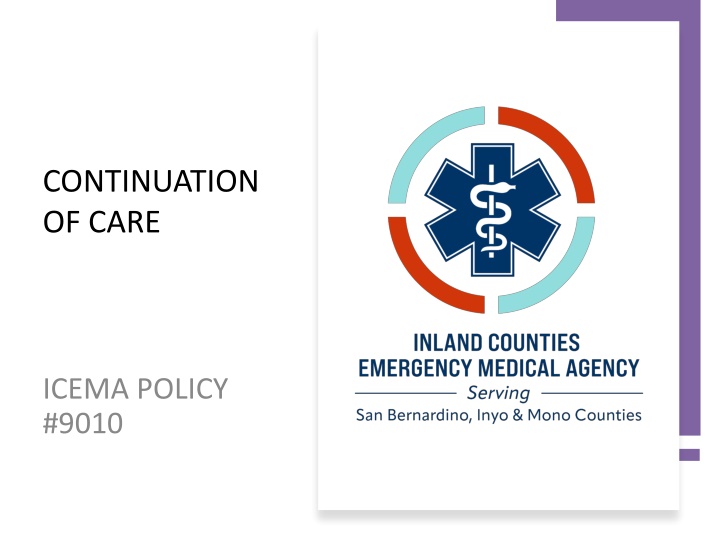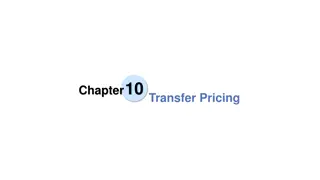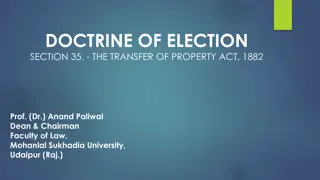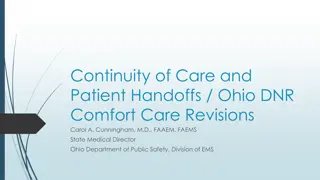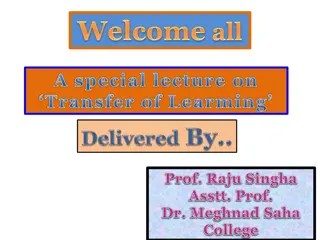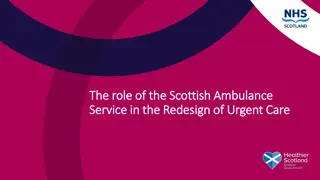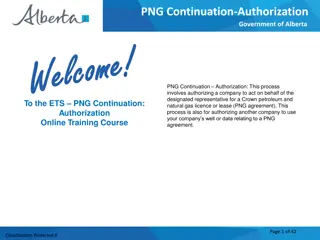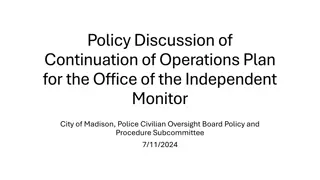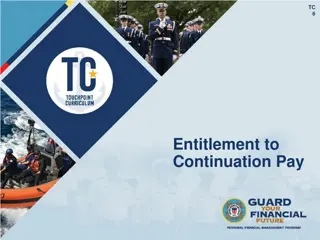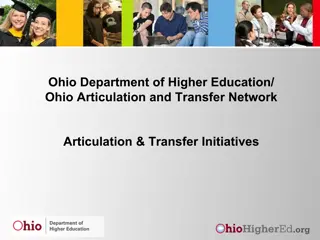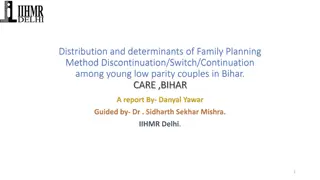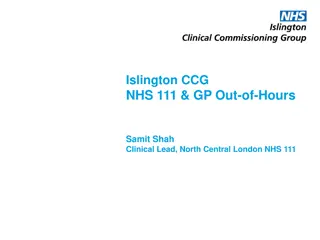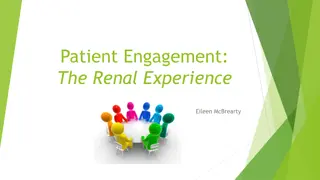ICEMA Policy #9010: Continuation of Care for Urgent Patient Transfer
This policy outlines the procedures for rapid transport and transfer of patients requiring urgent care to Specialty Care Centers by ICEMA Continuation of Care EMS Providers and Referral Hospitals. It includes criteria for Specialty Care Centers acceptance of trauma, STEMI, and stroke patients, designations for Trauma, STEMI, and Stroke Centers, and lists of specific Trauma, STEMI, and Stroke Receiving Centers.
Download Presentation

Please find below an Image/Link to download the presentation.
The content on the website is provided AS IS for your information and personal use only. It may not be sold, licensed, or shared on other websites without obtaining consent from the author.If you encounter any issues during the download, it is possible that the publisher has removed the file from their server.
You are allowed to download the files provided on this website for personal or commercial use, subject to the condition that they are used lawfully. All files are the property of their respective owners.
The content on the website is provided AS IS for your information and personal use only. It may not be sold, licensed, or shared on other websites without obtaining consent from the author.
E N D
Presentation Transcript
CONTINUATION OF CARE ICEMA POLICY #9010
PURPOSE To ensure the rapid transport of patients that require urgent transfer for higher level care at a Specialty Care Center.
Shall be used by: ICEMA Continuation of Care EMS Providers - to pit stop and stabilize Referral Hospital - to provide rapid assessment stabilization & transfer of STEMI, stroke and trauma patients to an appropriate Specialty Care Center Policy Specialty Care Centers - For the automatic acceptance of Trauma, STEMI, & Stroke Patients
4. Specialty Care Center ICEMA designated Trauma, STEMI, Stroke Center 5. Referral Hospital DEFINITIONS Any licensed general acute care hospital that is not an ICEMA designated Trauma, STEMI, or Stroke Center.
Trauma Center A licensed general acute care hospital designated by ICEMA as a trauma receiving center Level I-Level IV 2. STEMI receiving Centers A licensed general acute care hospital designated by ICEMA as a STEMI receiving center emergency interventional cardiac catheterization capabilities DEFINITIONS 3. Stroke Receiving Center A licensed acute care hospital designated by ICEMA as a Stroke receiging center Acute Ready, Primary, Thrombectomy Capable or Comprehensive stroke Center.
TRAUMA RECEIVING CENTERS Loma Linda University Children s Hospital-Level I Arrowhead Regional Medical Center-Level I Loma Linda University Medical Center-Level I Pomona Valley Hospital Medical Center-Level II (LA County) Desert Regional Medical Center- Level II (Riverside County) Hi-Desert Medical Center-Level IV
STEMI RECEIVING CENTERS Loma Linda University Medical Center Pomona Valley Hospital Medical Center (LA County) Desert Valley Hospital San Antonio Community Hospital St. Bernadine s Medical Center St. Mary Medical Center
STROKE RECEIVING CENTERS Redlands Community Hospital - Thrombectomy Capable Loma Linda University Medical Center - Comprehensive Arrowhead Regional Medical Center - Comprehensive San Antonio Community Hospital - Primary Pomona Valley Hospital Medical Center - Comprehensive (LA County) Desert Regional Medical Center - Comprehensive (Riverside Co) Kaiser Fontana - Primary Kaiser Ontario - Primary St Mary Medical Center - Primary St Bernardine Medical Center - Primary Hi-Desert Medical Center - Acute Ready
CONCEPT:EMS EMS providers that are transporting critically unstable patients to a STEMI, Stroke, or Trauma Center but need to stop at the closest receiving hospital for life saving critical interventions before continuing on to a specialty care center.
CONCEPT: EMS to Specialty Care Centers Is the patient s condition unstable? If YES! PIT STOP at the closest receiving hospital. Continue-on the immediate life- threatening condition is resolved.
CONCEPT: EMS Make Base Station contact Let them know that you are coming their way but will be pit stopping for patient stabilization. Don t forget to let the receiving hospital know too! Helicopter transport should be used if ground transport is expected to be >30 minutes
CONCEPTS: Referral Hospital EKG consistent with STEMI STEMI Center Meets trauma triage criteria Trauma Center Positive mLAPSS Stroke Center The referral hospital recognizes a critically injured patient that requires urgent transfer to a specialty care center: Identified LVO at Stroke Center Higher level of care Stroke Center Traumatic injuries at Trauma Center requiring higher level of care Higher level of care Trauma Center (Ex: cardiothoracic surgery)
CONCEPTS: Referral Hospital to Specialty Care Center Does the patient meet trauma triage criteria as per ICEMA policy If YES! Perform only life sustaining measures, e.g., airway stabilization, massive bleeding control etc Do not delay transfer for any unnecessary diagnostic procedures! Think If I get these tests, do I have the resources to provide an intervention? If not, do not delay use Continuation of Care
INITIAL TREATMENT GOALS AT REFERRAL HOSPITALS Initiate resuscitative measure within the capability of the facility Ensure patient stabilization is adequate for subsequent transport GOAL: Transfer time <30 minutes (door-in to door out) DO NOT Initiate unnecessary diagnostic procedures
TRANSFER PROCEDURE REFERRAL HOSPITAL The Referral hospital ED Physician will make a direct call to the ED physician @Specialty Care center The Referral ED Physician will determine if ground or air transport is necessary. If ground transport is > 30 minutes then air transport may be utilized
TRANSFER PROCEDURE SPECIALTY CARE CENTER The Specialty Care Center ED Physician will accept the trauma, STEMI, or Stroke patient (unless on internal disaster ICEMA policy # 8060) The ED Physician is the accepting physician at the Specialty Care Center. The receiving center will activate its internal Trauma Stroke or STEMI team according to their internal policy
TRANSFER PROCEDURE CONTD SIMULTANEOUSLY Call 9-1-1, using the following script: This is a Continuation of [ Trauma, STEMI, Stroke] from XXXX Hospital to XXXX Hospital. Dispatch will only send transporting ambulance without any fire apparatus DO NOT DELAY TRANSPORT for documents. The referral may FAX all patients documents to the Receiving Hospital E.g., Medical record, labs, x-rays, H&P s, reports and any other pertinent documentation.
SPECIAL CONSIDERATIONS If the patient arrived at the referral hospital by EMS the referral hospital ED Physician may request transport unit to remain with patient for minimal stabilization and transport immediately to the appropriate Specialty Care Center. The referral hospital may consider sending a Physician or Nurse with transport unit if deemed necessary due to patient condition or scope of practice
TEST YOUR KNOWLEDGE #1 75 year old patient, is brought into your community hospital with a family member with a deformed lower leg from a standing level, trip and fall. This patient states he did not hit his head, recalls the incident . GSC 15, AOX4, VS: BP 127/89; HR 102; RR 18; Pulse ox 100% on Room Air. Is this a Continuation of Care patient?
TEST YOUR KNOWLEDGE #1 ANSWER: No. This is not a Continuation of Care patient. This patient did NOT meet Trauma Triage Criteria.
TEST YOUR KNOWLEDGE #2 I have made contact with the nearest paramedic receiving hospital that I am coming in with a STEMI patient with CPR in progress. I need an airway and the closest SCC is 20 minutes away. The airway was stabilized at a RH and now I am en route to the SCC. What is the best next step?
TEST YOUR KNOWLEDGE #2 ANSWER: Make SCC Base Contact Do not assume that the RH has made contact with the Specialty Care Center. Call the appropriate Specialty Care Center and give a brief update and ETA.
TEST YOUR KNOWLEDGE #3 35 y.o high speed MVA, off the I-40 multiple traumatic injuries, with GCS of 13. Co-occupant death. Airship has been called, but with a delayed ETA. The patient s condition is deteriorating. She is becoming increasingly agitated, and the VS are becoming increasingly unstable. The closest trauma center is 1 hour 30 away by ground ambulance. The closest paramedic receiving center is 35 minutes away. What would you do?
TEST YOUR KNOWLEDGE #3 ANSWER: EMS: Do not delay on scene. Place patient in the ground ambulance and proceed to the closest paramedic receiving center. Make Trauma Base Hospital contact. Consider re-contacting airship to rendezvous at the RH for subsequent transport to the trauma center. RH: Stabilize the patient. Secure airway, control bleeding. Do not delay transport to obtain labs, XR s or scans. Contact SCC ED physician and call 9- 1-1 for Continuation , or coordinate with airship that may have already been called by EMS on-scene.
QUESTIONS? Thank You
REFERENCE PROTOCOLS # 9010 #14230 Suspected Acute Myocardial Infarction #9040 Trauma Triage Criteria Continuation of Care #9030 Destination #14080 Stroke Treatment-Adult #14090 Trauma Adult #14180 Trauma Pediatric Authority:- California Health and Safety code, Division 2.5, 1797.204 California Code of Regulation, Title 22
Acknowledgements Thank you to Dr. Alayna Prest, Dr. Michael Downes, Joy Peters, & Shawn Reynolds, for your contributions to this project.
ICEMA Continuing Education (CE) Information Thiscourse meets criteria for one (1) ICEMA Pre-Approved Core Course ICEMA Approved EMS Continuing Education Hours (CEH) This course has been approved for up to two (2) EMS Continuing Education hours (CEH) when administered by an approved California EMS CE Provider. BRN Continuing Education This course has been approved for up to (2) Continuing Education hours (CEH) when administered by an approved California EMS Provider.
